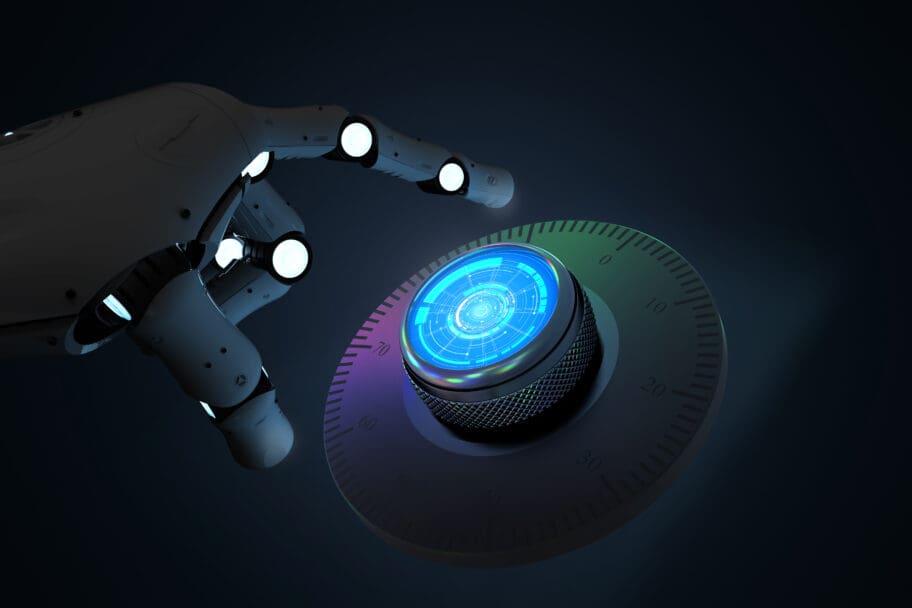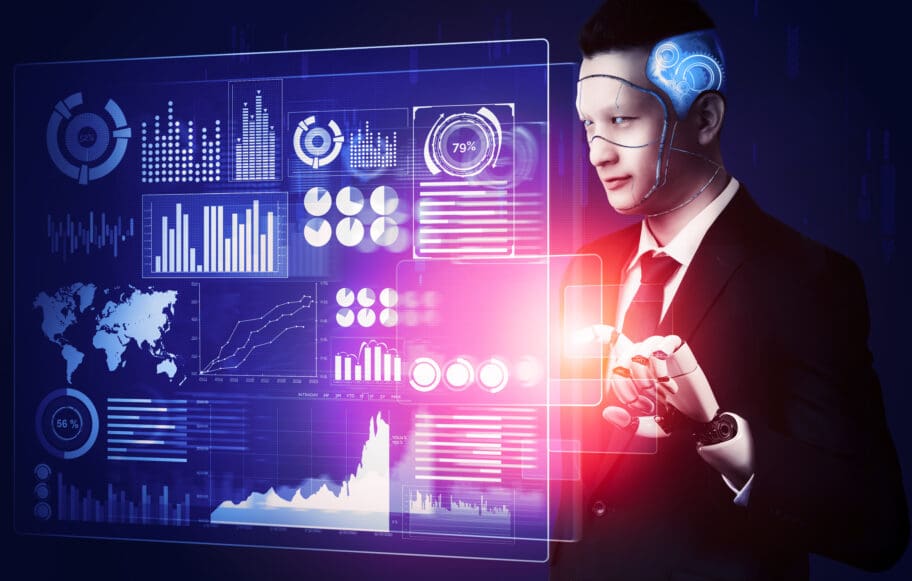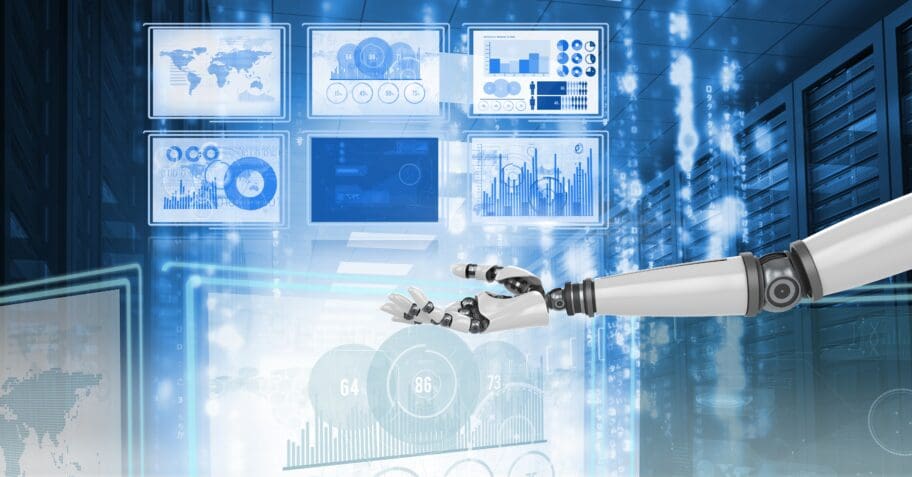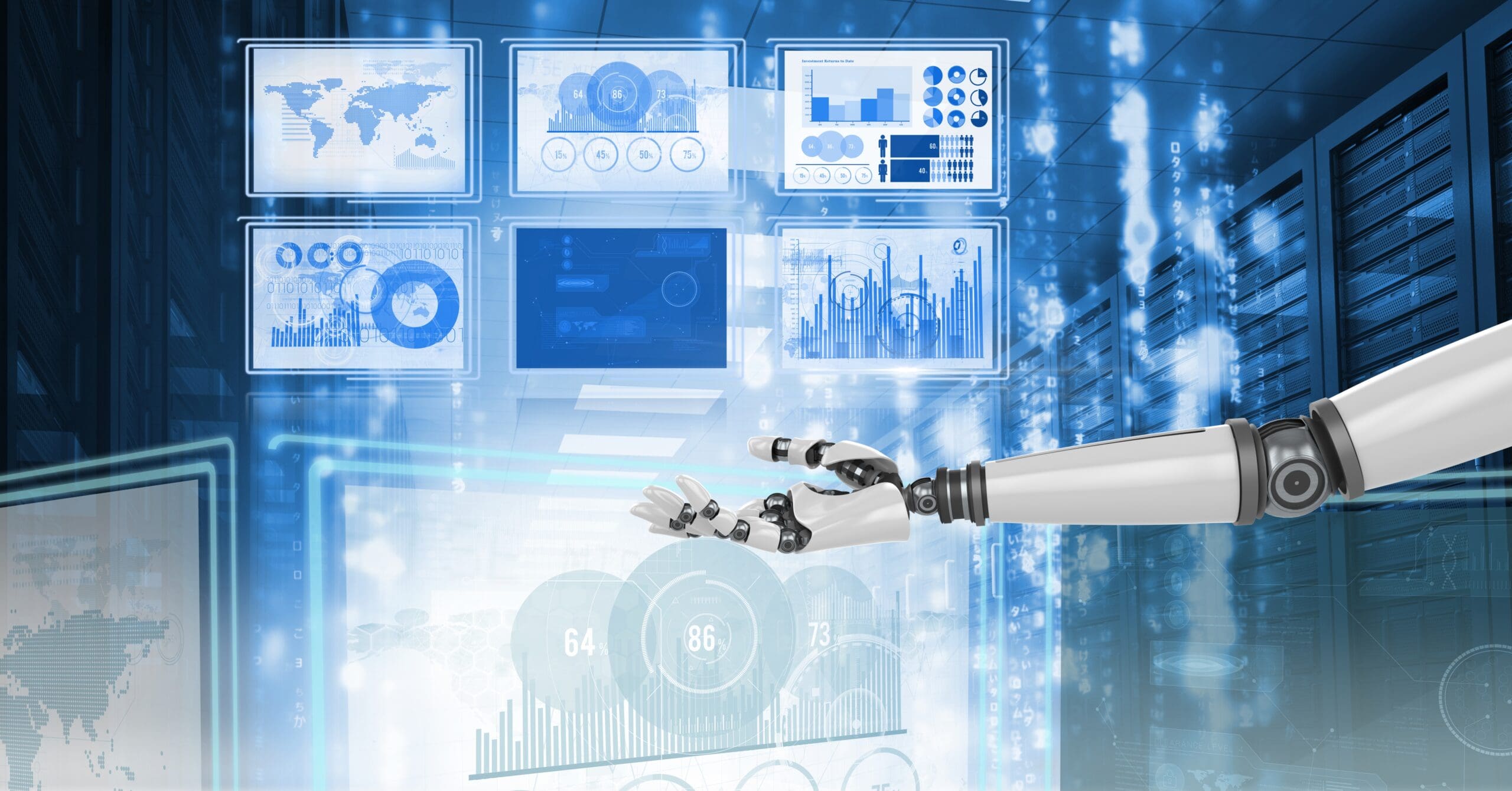Hey there, tech enthusiast! Ever wondered about the rising influence of AI, IoT, smart devices, industrial automation, autonomous robots, and smart homes in modern technology? Well, you're not alone. These two top business big guns are playing a pivotal role in shaping the future of the network world, specifically in industries around the globe through industrial automation and machine collaboration.
From Chatbot technologies to autonomous robots and industrial automation, AI is revolutionizing traditional business models - think smart homes, self-driving cars, personalized online shopping experiences - all made possible by this dynamic duo of machine collaboration and the internet. They're the driving force behind our increasingly connected world.

So why does this matter to you? Simply put, understanding how IoT and AI automation work together in smart homes, using the internet and robots, can give you an edge in this rapidly evolving digital landscape. So let's dive in together and explore this exciting world of smart, connected devices on the internet, where sharing on platforms is common and robots play a pivotal role!
The Role of AI in Industrial Automation
Boosting Productivity with AI
Imagine a factory where machines learn from their mistakes, constantly improving and enhancing productivity. Sounds like science fiction? Well, it's not! With AI tools such as machine learning algorithms and internet-based inference systems, robots are becoming a reality in industrial automation work. These generative AI-powered smart robots are programmed for industrial automation work, adapting and improving their performance over time through the internet. Industrial automation systems, including robots and generative AI, can analyze vast amounts of work-related data, identify patterns that humans might miss, and make adjustments to increase efficiency.
Predictive Maintenance: The New Normal
One of the biggest challenges in industrial automation is downtime, especially when internet connectivity issues affect work with robots. It's like a ticking time bomb in industrial automation that could explode at any moment, bringing work by robots on things to a halt. But what if, through industrial automation and internet control, you could predict when your robots are likely to fail? That's where AI comes into play. Predictive maintenance powered by industrial automation and artificial intelligence can monitor the health of robots and machines. Using the internet, it can alert operators at work about potential issues before they cause serious problems. Industrial automation not only reduces downtime but also extends the life of your robots and other equipment.
Making Decisions in Real-Time
In today’s fast-paced world, every second counts. Delayed decision making in industrial automation can lead to missed opportunities and decreased efficiency with robots. But here's good news - AI systems, like robots involved in industrial automation, can process information at lightning speed and make real-time decisions based on data analysis. Whether it's adjusting production parameters or rerouting materials on the fly, these intelligent robots can handle all aspects of industrial automation without human intervention.
Intelligent Automation Streamlining Processes
Ever wished for a magic wand, like industrial automation or robots, that could streamline all your processes? Well, guess what – artificial intelligence in robots and industrial automation might be that magic wand! By integrating AI and robots into industrial automation systems, businesses can automate complex tasks that were previously done manually by robots. From quality control checks to inventory management, these industrial automation robots handle everything with utmost precision and speed.
Here are some ways how:
- Automating repetitive tasks
- Optimizing resource allocation
- Enhancing quality control
- Reducing operational costs
AI isn't just about fancy robots doing cool stuff; it’s about transforming industries through intelligent automation.
Demand for AI, IoT, and Industrial Automation Technology
Efficient Data Management Systems
The need for efficient data management systems, such as robots, is surging across many industries. With the explosion of data from various sources such as social media, sensors, business transactions, and robots, traditional data management systems are falling short in handling this deluge. Cue in technologies like AI and IoT. These robot technologies offer advanced ways to collect, store, process and analyze vast amounts of data with speed and accuracy that no human or conventional computer system can match.
For example, an AI-powered system, such as robots, can sift through millions of data points in seconds to identify patterns or anomalies that could indicate a potential problem or opportunity. This level of efficiency in robots not only saves time but also reduces the risk of errors that could cost companies dearly.
Manufacturing Sector's Interest
In the manufacturing sector specifically, there's a growing interest in these robot technologies as a way to reduce costs. By integrating AI and IoT into their operations, manufacturers can automate routine tasks that would otherwise require a large workforce. This not only reduces labor costs but also increases productivity as machines can work round-the-clock without breaks.
Moreover, these technologies enable real-time monitoring of production processes which allows for immediate response to any issues thereby minimizing downtime. For instance, if a machine malfunctions on the production line, an IoT sensor can instantly alert the engineering team who can then quickly address the issue before it escalates.
Potential ROI Improvement
The high demand for AI and IoT is also driven by their potential to improve ROI. Companies investing in these technologies are seeing significant returns in terms of increased efficiency, reduced operational costs and improved product quality which ultimately leads to higher profits.
A study by Accenture found that industrial firms implementing AI could boost profitability by an average of 39% by 2035. That's a value proposition hard to ignore!
Predictive Analytics Adoption Rate
Lastly but importantly is the necessity for predictive analytics driving up adoption rates of these technologies. In today's highly competitive market environment where customer expectations are constantly evolving, businesses need insights into future trends so they can stay ahead of the curve.
AI provides those insights through predictive analytics – analyzing historical data to predict future outcomes.
Innovation through AI and IoT Integration
Imagine living in a smart home, where devices can predict your needs and cater to them without any human intervention. This isn't a scene from a sci-fi movie, but the reality of integrating AI (Artificial Intelligence) and IoT (Internet of Things).

Smarter Applications Through Combined Technologies
The combination of AI and IoT has paved the way for smarter applications. These applications have capabilities beyond our imagination. For instance, generative AI integrated with smart devices can learn from human behavior and adapt accordingly. It's like having a personal assistant who knows your preferences better than you do!
Now, let's take an example of cloud computing platforms that leverage this integration to provide advanced services. They offer solutions based on machine learning algorithms that process data generated by IoT devices in real-time.
Personalized User Experience
Personalization is no longer just about suggesting products or services based on past purchases. With AIoT integration, it's about making every interaction meaningful and relevant to the user.
For instance, think about smart homes equipped with intelligent appliances. These appliances can adjust their operations based on your habits or preferences. The coffee maker starts brewing as soon as your alarm goes off in the morning, or the air conditioner adjusts its temperature according to weather forecasts.
Advanced Security Measures
Security is always a concern in our network world. However, combining AI with IoT has given rise to advanced security measures that were previously unimaginable.
AIoT integration enables real-time monitoring and control over all connected devices within a network. It can detect any abnormalities or potential threats in the system before they become significant issues.
Let's consider an example: A security camera equipped with facial recognition technology can identify unfamiliar faces around your home and alert you instantly via your smartphone.
Real-Time Monitoring And Control
In addition to enhancing security measures, real-time monitoring also allows for immediate response to any changes or anomalies detected by IoT devices.
For instance, if an industrial sensor detects an unusual spike in temperature during manufacturing processes, it could trigger an automatic shutdown preventing potential damage or loss.
This level of automation not only increases efficiency but also reduces reliance on constant human intelligence input.
Benefits of IoT and AI Integration
Boosted Operational Efficiency
Imagine a world where machines talk to each other, making decisions without human intervention. That's what you get with the integration of IoT and AI automation - a seamless blend of technology that can skyrocket operational efficiency across various sectors. For instance:
- Manufacturing plants using smart sensors to monitor equipment health, reducing downtime.
- Logistics companies leveraging real-time tracking for efficient route planning.
- Energy firms optimizing power generation and distribution through predictive analytics.
These are just the tip of the iceberg! The potential benefits are endless, transforming businesses into lean, mean, tech-savvy machines.
Data Driven Decision Making
Ever heard the phrase "knowledge is power"? In today's digital age, data is king. With IoT devices generating zettabytes of data every second and AI algorithms crunching these numbers in real-time, businesses can make more informed decisions. Whether it's predicting customer behavior or identifying market trends before they happen, this dynamic duo has got you covered!
Revolutionizing Customer Service
Who likes waiting on hold? Not me! Thanks to IoT and AI automation, those days could be numbered. Imagine smart bots handling basic customer queries or intelligent systems predicting issues before customers even realize there's a problem. Now that's what I call service!
Reliable System Performance
It's no secret that system reliability can make or break a business. Thankfully, integrating IoT with AI can significantly enhance system performance and reliability. Think about it: self-healing networks that fix themselves or predictive maintenance that prevents failures before they occur.
The bottom line? If you're looking for ways to boost efficiency, make smarter decisions, revolutionize customer service experiences or increase system reliability – then integrating IoT and AI automation might just be your golden ticket!
Case Study: Business Applications of AIoT
Improved Supply Chain Management
Imagine a world where your supply chain management is as easy as pie. That's what AIoT applications bring to the table. For example, a company can use IoT applications to track goods in real-time, reducing uncertainties and enabling proactive problem-solving. The application of AI takes this a step further by predicting future demand patterns, ensuring optimal inventory levels at all times. It's like having a crystal ball that keeps your business steps ahead of the competition.
Enhanced Customer Engagement Strategies
Let's face it; customers are the lifeblood of any business. Engaging them effectively is crucial for success. Here's where AIoT shines! By integrating both technologies, businesses can offer personalized experiences based on customer behavior data collected from various touchpoints. Imagine a retail store that suggests products based on your past purchases or browsing history – pretty neat, huh?
Increased Revenue Generation
Who doesn't want to make more money? With predictive analysis tools powered by AIoT, businesses can identify new revenue opportunities before they're even visible on the horizon. Think about it: using historical sales data and market trends, these tools can predict which products are likely to be hits in the future. It’s like having your own fortune teller whispering winning lottery numbers into your ear!
Reduced Operational Costs
Running a business isn't cheap – we all know that! But what if you could cut down on operational costs without compromising efficiency? Enter automated processes enabled by AIoT! By automating repetitive tasks, businesses not only save time but also reduce errors caused by human intervention.
Here’s an example:
- Before automation: A worker spends 2 hours daily updating inventory records.
- After automation: An IoT application updates inventory records in real-time – no human intervention required!
The result? More time for workers to focus on tasks that matter and fewer errors in record-keeping.
Role of IoT and AI in Business Analysis Processing
Accurate Forecasting
IoT and AI automation are like the dynamic duo of business analysis. They're the Batman and Robin, if you will, that take big data analysis tools to a whole new level. With these two at the helm, businesses can accurately predict future trends, customer behavior, and even market changes. It’s like having a crystal ball that doesn’t just tell you what might happen but gives you hard facts based on solid data.
Let's paint a picture here: Imagine you run an e-commerce store. With IoT devices collecting data from every user interaction and AI processing this information in real-time, you'd know exactly when your customers are most active, what products they're likely to buy next, or even when they're about to abandon their shopping cart! This kind of information is invaluable for accurate forecasting.
Real-Time Tracking & Reporting
Now let's talk about real-time tracking & reporting. It's like having a bird’s eye view of your entire operation 24/7. IoT devices collect data from every corner of your business while AI processes this information on-the-fly.
Imagine running a logistics company with hundreds of trucks on the road. With IoT sensors installed in each vehicle and AI analyzing this data in real-time, you'd know exactly where each truck is at any given time, how fast it's going or if there are any mechanical issues that need attention ASAP.
Data Visualization Techniques
Data visualization is another superpower offered by IoT and AI automation combo. Think Iron Man’s Jarvis showing Tony Stark all those fancy 3D holographic displays—that’s what we’re talking about here!
With IoT collecting tons of raw data from various sources (websites, social media platforms, customer feedback forms etc.) and AI processing it into understandable chunks—businesses can visualize complex datasets in easy-to-understand graphs or charts.
This makes strategic planning less like shooting in the dark and more like playing chess—you see all the pieces on the board clearly before making your move!
Personalized Marketing Strategies
Lastly but definitely not leastly—personalized marketing strategies are another ace up IoT & AI (https://www.lantronix.com/) automation sleeve!
Efficiency Boost: AI and IoT in Operations
Reducing Human Error
Automated operations, powered by the combined technology of an iot system and artificial intelligence (AI), drastically reduce human error. Imagine a warehouse where machines are doing the heavy lifting, guided by AI's superior decision-making abilities. It's like having a top business manager on duty 24/7, making sure everything runs smoothly without any delays.
- Example: A switch controlled by an IoT device can turn off machinery if it detects abnormal behavior, preventing accidents before they happen.
Smart Resource Allocation
Next up is improving resource allocation & utilization. This is where smart scheduling features offered by integrated technology come into play. With real-time monitoring capabilities, businesses can increase their efficiency and control loop processes more effectively.
- Case Study: An international shipping company used AI to optimize its routes and saved millions in fuel costs.
Quick Response Times
The ability to respond quickly to critical issues is another significant benefit of combining AI with IoT. Real-time monitoring allows for immediate inference when something goes wrong, enabling businesses to act swiftly and minimize damage or downtime.
- Stat: A recent study found that companies using IoT saw a 25% reduction in response times.
Predictive Maintenance for Uptime Maximization
Lastly, let's talk about maximizing uptime & minimizing downtime through predictive maintenance features enabled by integrated tech. This approach uses ML (Machine Learning) algorithms to predict potential equipment failures before they occur, allowing for proactive maintenance rather than reactive repairs.
- Social Proof: "Since we started using predictive maintenance tools powered by AI and IoT," says a warehouse manager from a leading e-commerce company, "we've seen our downtime decrease significantly."
In essence:
- Automated operations reduce human error.
- Smart scheduling improves resource allocation.
- Real-time monitoring accelerates response time.
- Predictive maintenance maximizes uptime.
So there you have it! By integrating AI and IoT into your operations, you're not just adding some fancy tech – you're giving your business an efficiency boost that could save you time, money, and headaches down the line!
Future Prospects: Self-driving Cars, AI and IoT
Safer Roads Ahead
Imagine a world where autonomous robots take over the driving tasks, reducing human error and risk. This isn't some far-off future dream, it's happening now with the integration of IoT and AI automation in self-driving cars. These tech-powered vehicles are designed to make real-world decisions based on various conditions like traffic lights, weather, and other vehicles on the road. The result? Safer roads for everyone.
Decongesting Traffic
Who doesn't dread being stuck in traffic? The good news is that this era of standstills could soon be history. Smart routing algorithms offered by integrated technology like IoT and AI are revolutionizing how we navigate our roads. By analyzing real-time data from various sources such as traffic cameras and social media updates, these algorithms can predict congestion points and suggest alternate routes for drivers or even reroute autonomous vehicles automatically.
Lowering Carbon Footprint
The world is becoming increasingly aware of the need to reduce carbon footprint. Integrated technology provides an advanced solution by offering energy-efficient alternatives in transportation. For instance, smart trucks enabled with IoT devices can optimize fuel consumption based on route conditions while AI can automate tasks to minimize energy wastage.
Here's a quick comparison:
| Traditional Trucks | Smart Trucks |
|---|---|
| High fuel consumption | Optimized fuel usage |
| Manual operation | Automated tasks |
These advancements not only contribute to environmental sustainability but also save costs in the long run.
Transforming Transportation Industry
Shared mobility solutions are reshaping people's lives across the globe. Think Uber but without a human driver! This new wave of transportation powered by combined tech like IoT and AI automation allows people to share rides using autonomous vehicles that can pick up goods or passengers from multiple locations efficiently.
This transformation goes beyond just convenience:
- Reduces vehicle ownership
- Promotes shared economy
- Lowers transportation cost
- Increases accessibility for all
In this rapidly evolving landscape, security remains paramount as well – ensuring that these technologies are safe from cyber threats is crucial in maintaining trust among users.
So there you have it folks!
Data Tracking and Management in IoT and AI
Secure Data Storage & Transfer
IoT and AI automation have revolutionized data tracking and management. One of the key aspects of this transformation is secure data storage and transfer, made possible through encryption methods offered by combined tech. Picture a lockbox that only opens with the right key. That's what data encryption does for your digital info. It keeps it safe from prying eyes, ensuring only authorized users can access it.
- Example: A smart home system collects data points from various sensors around the house. This could be anything from temperature readings to security camera footage. The system then encrypts this data before sending it over the internet to a secure server or cloud-based solution.
Seamless Access to Information
Cloud-based solutions provided by combined tech facilitate seamless access to information across platforms. Think about how easy it is to pull up a document on Google Drive whether you're on your phone, tablet, or computer. This same concept applies here.
- Case Study: A manufacturing company uses IoT sensors to track production metrics in real-time. These data points are stored in a cloud-based system that can be accessed anywhere, anytime – allowing for quick decision-making and improved efficiency.
Regulatory Compliance
Automated record-keeping features enabled by integrated tech enhance regulatory compliance too! Imagine having an automatic logbook that records every action taken within your system – no more manual entries or missing records!
- Stats: According to a 2020 survey conducted by Deloitte, 73% of organizations reported improved regulatory compliance due to their implementation of AI-powered automated record-keeping systems.
Data Quality & Integrity
Lastly, validation checks implemented by combined tech optimize data quality & integrity. It's like having a super-smart proofreader who never misses a mistake!
- An IoT device collects raw data.
- The AI automation software validates this data against predetermined parameters.
- If any discrepancies are detected, they are flagged for review.
- This ensures only accurate and reliable information is used for decision-making processes.
Healthcare Transformation via AI and IoT
Patient Care Delivery Revolution
The digital transformation has brought about a revolution in patient care delivery. With the help of remote monitoring tools powered by combined tech of IoT and AI automation, healthcare providers are now able to monitor patients' health conditions in real-time.
For instance, with smart IoT devices (https://www.lantronix.com/) like wearable fitness trackers or heart rate monitors, doctors can keep an eye on their patients' vital signs without them having to step foot into the clinic. This not only saves time for both parties but also allows for immediate intervention if any anomalies are detected.
Diagnostic Accuracy Enhancement
AI-based image analysis techniques enabled by integrated tech have significantly enhanced diagnostic accuracy. These advanced solutions can analyze medical images such as X-rays or MRIs, identify patterns that might be missed by human eyes, and provide highly accurate diagnoses.
Take Google's DeepMind AI system as an example. It was able to outperform six radiologists in detecting breast cancer from mammograms according to a study published in Nature. This clearly illustrates how AI and IoT are reshaping healthcare.
Administrative Tasks Streamlining
Automated workflow solutions provided by combined tech have been instrumental in streamlining administrative tasks within healthcare facilities. For example:
- Automating appointment scheduling
- Managing patient records digitally
- Tracking inventory of medical supplies
These tasks that were once manual and time-consuming can now be done efficiently with minimal errors, freeing up staff to focus more on patient care.
Preventive Healthcare Promotion
Lastly, personalized health insights generated by integrated tech are promoting preventive healthcare like never before. Patients can receive tailored health advice based on data collected from their IoT devices - whether it's about maintaining a balanced diet or following a specific exercise regimen.
Moreover, predictive analytics powered by AI can alert individuals about potential health risks before they become serious issues - making prevention better than cure more than just an adage.
Wrapping Up the IoT and AI Automation Journey

So, there you have it. We've traveled through the landscape of IoT and AI automation, from its role in industrial settings to future prospects like self-driving cars. It's clear as day that this tech combo is no flash in the pan; it's here to stay and will continue transforming industries left, right, and center.
Now it's your turn to jump on this bandwagon. Don't sit back and watch as others reap the benefits of AIoT integration. Whether you're running a business or just curious about tech trends, keep your eyes peeled for ways you can tap into this dynamic duo. Remember, staying ahead of the curve isn't just about keeping up with trends—it's about being ready to ride the wave when it comes!
FAQs
What are IoT and AI automation?
IoT (Internet of Things) refers to a network of interconnected devices that collect and share data. When combined with Artificial Intelligence (AI), these devices can analyze data patterns and make decisions autonomously—this is what we call IoT and AI automation.
How does IoT and AI automation benefit businesses?
Businesses can leverage IoT and AI automation for improved efficiency in operations, accurate business analysis processing, innovative solutions, better data management, among other benefits.
Are there any real-world applications of IoT and AI?
Yes! From healthcare transformation to self-driving cars, IoT integrated with AI (AIoT) has found applications across various sectors.
Is investing in IoT and AI technology worth it for small businesses?
Absolutely! While initial setup costs might be significant, the long-term benefits such as operational efficiency improvement make it a worthwhile investment.
How does IoT aid in data tracking & management?
IoT devices collect vast amounts of data from their environment. This information can then be analyzed by artificial intelligence systems for insights or used to automate processes based on specific triggers.

Article by
Titus Mulquiney
Hi, I'm Titus, an AI fanatic, automation expert, application designer and founder of Octavius AI. My mission is to help people like you automate your business to save costs and supercharge business growth!
